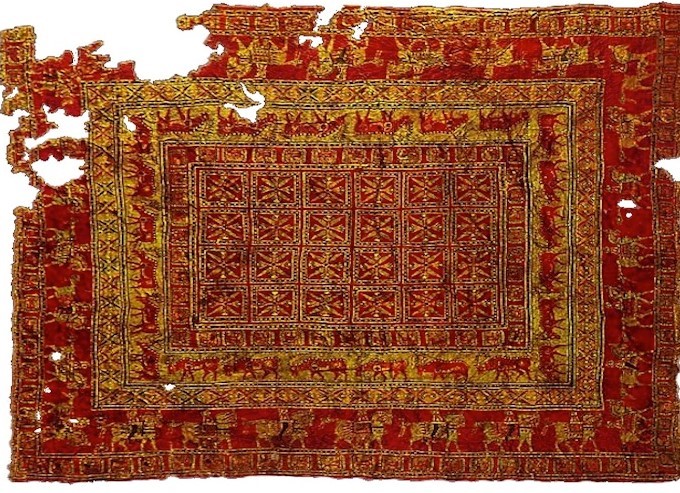Handmade oriental rugs have been meticulously made for more than two thousand years according to rich local traditions.
Textile art has been influenced by cultures all over the world. Oriental carpets add rich beauty and sophisticated comfort to every space, from the simplest of homes to the most opulent palaces.

What are Oriental Rugs?
Oriental handmade rugs are carpets hand-knotted solely in Asia, according to the strictest definition. Iran, China, India, Russia, Turkey, Pakistan, Tibet, and Nepal are among the world's leading rug exporters.
Persian carpets are Oriental rugs that are solely created in Iran (formerly known as Persia). An exceedingly deep pile (up to 160 knots per square inch), highly rich color combinations and distinctive designs, and a very distinct knot are all characteristics of a Persian rug.
Moreover, Persian carpets have long been prized for their wide range of patterns, color, sizes, and weaving. They're also noted for the originality of every rug they make. Rugs are usually called for the village, town, or area where they are weaved or gathered, or, in the case of nomadic pieces, by the weaving tribe.
Brief History
Before the 1st century BC, rugs in Western Asia had progressed beyond felt and plaited mats. A threshold rug with an allover field design of quatrefoils, bordered by a lotus border, is seen in a stone carving from the Assyrian palace of Khorsabad in contemporary Iraq from the 8th century BC. Patterns from other Assyrian sculptures from the same period can also be seen in current designers' collections.
The first known specimens of knotting were discovered during an excavation of royal burials in Pazyryk, in the Altai Mountains of southern Siberia, ranging from the 5th to the 3rd century BC. Among the discoveries are appliquéd felt items and a magnificent woolen pile carpet tied with the symmetrical, or Turkish, knot in the Hermitage. The carpet, which might be Persian in origin, is 6 x 6.5 feet long. A checkerboard design dominates the center field, with a flowery star pattern in each square. The inner of the two large borders features an elk frieze, while the outer features a horsemen frieze.
Furthermore, Asia Minor and the Caucasus produced coarse, brightly colored rugs with stars, polygons, and typically stylized Kfic lettering patterns in the 13th, 14th, and 15th centuries. The most notable of these carpets are represented by seven remnants of powerful, recurring geometric designs in brilliant colors—red, yellow, and blue—found in the mosque of Al al-Dn Kay-Qubd I at Konya in Anatolia and now at the Museum of Turkish and Islamic Art, Istanbul.
Thereafter, more carpets with finer weaves, more delicate designs, and richer colors came in Europe, predominantly geometric and probably from Asia Minor. Many of these motifs may still be seen in the Bergama area of Asia Minor and the southern Caucasus, making dating difficult. Oriental rugs for sale can be found easily if you are interested.
The Oldest Persian Rug – Pazyryk
Poetry and music have always been a part of the Iranian soul and spirit. These are undeniably some of the highlights of Iranian culture, but maybe none is more well-known and magnificent than Persian carpets, notably the Pazyryk Persian Rug.
As aforementioned, the Pazyryk was discovered during the excavation of royal burials. The Pazyryk rug was discovered in the Altai Mountains of Kazakhstan in 1949, miraculously excavated by Russian archaeologists in the frozen tomb of a Scythian nobleman. The rug was constructed somewhere in the 5th century BC and is the oldest surviving piled rug currently in existence, according to our understanding. It has remained frozen for almost 2500 years. It is presently on display in the Hermitage Museum in St. Petersburg. Pazyryk's story begins with the Scythian people, who began spreading out from central Asia in the 9th century BC into western Mongolia, southern Russia, Europe, and other regions of the Mediterranean and Egypt.
Because of its intricate weaving, color, and pattern, as well as the fact that it is the oldest rug in existence, the Pazyryk Rug intrigues us. It stands out because it has a high degree of skill and intricacy, demonstrating Persia's lengthy tradition of carpet weaving.
This magnificent rug is 1.832 meters long and features 36 symmetrical knots per 2 cm woven in the method of the symmetrical double knot, often known as the Turkish knot (or more than 1,250,000 knots). It features an extremely elaborate and complicated design that combines geometric, floral, and pictorial designs cleverly.
The Scythians had a strong connection to the metaphysical, heavenly, and animal realms, as seen by the motifs on this exquisite carpet. It has a rich and varied decoration: the central field is occupied by 24 cross-shaped figures, each of which is made up of four stylized lotus buds symbolizing their sun-attunement.
The Scythians had a strong connection to the metaphysical, heavenly, and animal realms, as seen by the motifs on this exquisite carpet. It has a rich and varied decoration: the central field is occupied by 24 cross-shaped figures, each of which is made up of four stylized lotus buds symbolizing their sun-attunement. This piece is framed by a border of griffins, which symbolize redemption guardians, and a border of twenty-four fallow deer, which represent longevity and knowledge.
The rug is a magnificent piece of art. The Pazyryk and other antique rugs will give an insight into the culture and beliefs of the ancient people of Persia. The people have immortalized their culture by weaving it into these rugs.
Antique rugs, whether they’re from the Pakistani rugs family or any other type of Oriental rug, would surely a touch of tribal splendor to your house and evoke a sense of connectedness to the natural world.













